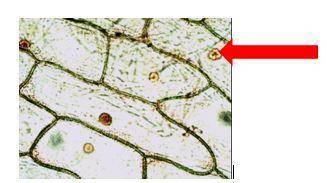
Biology, 15.09.2021 09:20 livy151515
What are the 2 types of cells (not plant and animal)? Describe each type. Are you made of prokaryotic or eukaryotic cells? Explain why you chose your answer. Are bacteria prokaryotic or eukaryotic? Explain why you chose your answer. What parts do all cells have in common? List at least 2. Create Cell Analogies: for example, compare a cell to a castle The cell wall is like the walls because it protects the castle The cell membrane is like the drawbridge because it lets certain things in and out The vacuoles are like the storage rooms because they both store things Your turn! Pick an item like an airplane, basketball gym/baseball field, house, or school to complete your own analogies below. You can pick different organelles as well. See examples above. 5. The _is like _because _ 6. The _is like_because _ 7. The _is like _because _ Label the numbered parts of the cell: 8. _ 9. _ 10._ 11._ Refer to the onion image to answer the following 2 questions: 12. Using the onion cell diagram above, which organelle is responsible for the greenish color? 13. Which organelle is the red arrow pointing towards? 14. Both plant and animal cells contain mitochondrion however they are not in equal amounts. Between the cheek and onion cells, which one do you think would contains the greater amount of mitochondrion and why? 15. Compare in your own words, at least 2 differences in plant and animal cells. 16. Why does a plant cell need a larger vacuole? 17. Animal cell do not have chloroplasts. Why not? 18. What are the 3 components of the cell theory? Put in your own words. 19. Choose one part of the Cell Theory and describe an experiment you could do that would give evidence to support your claim. 20. How can a microscopic paramecium and a large giraffe both be described by the cell theory?



Answers: 2
Another question on Biology

Biology, 21.06.2019 18:30
Match the type of adaptation to the correct example, structural adaptation functional adaptation behavioral adaptation example type of adaptation elephants live in herds to protect their young leaves of a rain forest plant species have a pointed tip that enables rainwater to drain off easily. camels have nostrils that they can close snakes produce venom to kill prey and defend themselves. earthworms coil when touched, as part of a defense mechanism. human skin darkens with increased exposure to sunlight.
Answers: 3

Biology, 21.06.2019 20:00
The observations of hooke and van leeuwenhoek documenting the existence of microscopic cells formed the basis of what important theory? a. the cell theory stating that all living things are composed of cellsb. the theory of spontaneous generation, which held that life forms could arise spontaneouslyc. the theory of chemotherapy, or use of antimicrobials to destroy pathogenic organismsd. the germ theory of disease and causative agents
Answers: 1

Biology, 22.06.2019 09:30
Phosgene is a chemical agent that is formed by decomposition of chlorinated hydrocarbon solvents by ultraviolet radiation. a. false b. true
Answers: 1

Biology, 22.06.2019 21:00
Me i need this asap during photosynthesis, the following reaction takes place: carbon dioxide + water + light energy → sugar + oxygen during cellular respiration, the following reaction takes place: sugar + oxygen → carbon dioxide + water + chemical energy given this information, how are photosynthesis and cellular respiration related? question 2 options: the products of photosynthesis are the reactants of cellular respiration. photosynthesis and cellular respiration both start with the same materials. photosynthesis and cellular respiration both produce the same materials. the same type of energy is found in both photosynthesis and cellular respiration.
Answers: 1
You know the right answer?
What are the 2 types of cells (not plant and animal)? Describe each type. Are you made of prokaryoti...
Questions

Mathematics, 30.08.2019 00:30

Business, 30.08.2019 00:30



Computers and Technology, 30.08.2019 00:30


History, 30.08.2019 00:30

History, 30.08.2019 00:30

Biology, 30.08.2019 00:30

Computers and Technology, 30.08.2019 00:30

English, 30.08.2019 00:30



Mathematics, 30.08.2019 00:30






Mathematics, 30.08.2019 00:30



